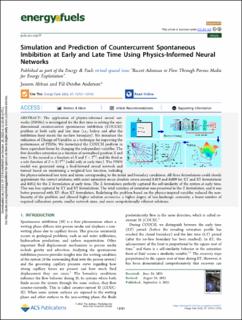| dc.contributor.author | Abbasi, Jassem | |
| dc.contributor.author | Andersen, Pål Østebø | |
| dc.date.accessioned | 2023-10-19T13:27:48Z | |
| dc.date.available | 2023-10-19T13:27:48Z | |
| dc.date.created | 2023-08-28T08:16:15Z | |
| dc.date.issued | 2023-09 | |
| dc.identifier.citation | Abbasi, J. & Andersen, P.Ø. (2023) Simulation and Prediction of Countercurrent Spontaneous Imbibition at Early and Late Time Using Physics-Informed Neural Networks. Energy & Fuels, 37, 18, 13721–13733 | en_US |
| dc.identifier.issn | 0887-0624 | |
| dc.identifier.uri | https://hdl.handle.net/11250/3097614 | |
| dc.description.abstract | The application of physics-informed neural networks (PINNs) is investigated for the first time in solving the one-dimensional countercurrent spontaneous imbibition (COUCSI) problem at both early and late time (i.e., before and after the imbibition front meets the no-flow boundary). We introduce the utilization of Change-of-Variables as a technique for improving the performance of PINNs. We formulated the COUCSI problem in three equivalent forms by changing the independent variables. The first describes saturation as a function of normalized position X and time T; the second as a function of X and Y = T0.5; and the third as a sole function of Z = X/T0.5 (valid only at early time). The PINN model was generated using a feed-forward neural network and trained based on minimizing a weighted loss function, including the physics-informed loss term and terms corresponding to the initial and boundary conditions. All three formulations could closely approximate the correct solutions, with water saturation mean absolute errors around 0.019 and 0.009 for XT and XY formulations and 0.012 for the Z formulation at early time. The Z formulation perfectly captured the self-similarity of the system at early time. This was less captured by XT and XY formulations. The total variation of saturation was preserved in the Z formulation, and it was better preserved with XY- than XT formulation. Redefining the problem based on the physics-inspired variables reduced the non-linearity of the problem and allowed higher solution accuracies, a higher degree of loss-landscape convexity, a lower number of required collocation points, smaller network sizes, and more computationally efficient solutions. | en_US |
| dc.language.iso | eng | en_US |
| dc.publisher | American Chemical Society | en_US |
| dc.rights | Navngivelse 4.0 Internasjonal | * |
| dc.rights.uri | http://creativecommons.org/licenses/by/4.0/deed.no | * |
| dc.title | Simulation and Prediction of Countercurrent Spontaneous Imbibition at Early and Late Time Using Physics-Informed Neural Networks | en_US |
| dc.type | Peer reviewed | en_US |
| dc.type | Journal article | en_US |
| dc.description.version | publishedVersion | en_US |
| dc.rights.holder | © 2023 The Authors | en_US |
| dc.subject.nsi | VDP::Teknologi: 500::Berg‑ og petroleumsfag: 510 | en_US |
| dc.source.pagenumber | 13721–13733 | en_US |
| dc.source.volume | 37 | en_US |
| dc.source.journal | Energy & Fuels | en_US |
| dc.identifier.doi | 10.1021/acs.energyfuels.3c02271 | |
| dc.identifier.cristin | 2169999 | |
| dc.relation.project | Norges forskningsråd: 331644 | en_US |
| cristin.ispublished | true | |
| cristin.fulltext | original | |
| cristin.qualitycode | 2 | |

